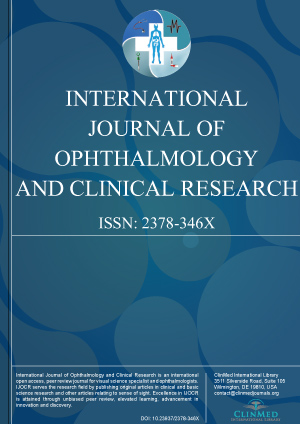Open Access DOI:10.23937/2378-346X/1410057
Orbital Contracture Repair Using the Radial Forearm Free Flap: A Nine and Ten Year Follow-up
Brian T Andrews, Russell B Smith, Todd E Thurston and Keith D Carter
Article Type: Case Series | First Published: June 01, 2016
Introduction: Orbital contracture is a severe cicatricial process within the enucleated orbit prohibiting the use of an ocular prosthesis and often requires socket expansion procedures. We hypothesize that the RFFF provides stable long-term expansion of the contracted orbit and allows for continued ocular prosthesis use without the accumulation of keratin debris. Methods: A retrospective chart review was performed at the University of Iowa Hospitals and Clinics....
Open Access DOI:10.23937/2378-346X/1410056
Introduction of a Toric Intraocular Lens to a Non-Refractive Cataract Practice: Challenges and Outcomes
Clare Kirwan, John M Nolan, Jim Stack, Ian Dooley, Johnny Moore, Tara CB Moore and Stephen Beatty
Article Type: Research Article | First Published: May 25, 2016
Aim: To identify challenges inherent in introducing a toric intraocular lens (IOL) to a non-refractive cataract practice, and evaluate residual astigmatism achieved and its impact on patient satisfaction. Methods: Following introduction of a toric IOL to a cataract practice with all procedures undertaken by a single, non-refractive, surgeon (SB), pre-operative, intra-operative and post-operative data was analysed. Attenuation of anticipated post-operative astigmatism was examined, and subjective...
Open Access DOI:10.23937/2378-346X/1410055
Blue-colored Cystic Mass in Newborn Babies
Titap Yazicioglu and Isil Kutluturk
Article Type: Research Article | First Published: May 25, 2016
The medical records of twelve newborn infants between 15 days and 3 months of age, with the presence of an unilateral dark-blue mass in the medial canthal region, as soon as after birth, were rewieved retrospectively. The management protocol was consisted of the warm compress and massage over the mass, and antibiotics when dacryocystitis developed. Nasolacrimal duct probing was performed in cases of no spontaneous resolution. Patients age at the time of clinical examination, presence of retrogra...
Open Access DOI:10.23937/2378-346X/1410052
Binocular Correction in Patients with Central Retinal Impairment
Mgr. Matej Skrbek and MUDr. Svatopluk Synek
Article Type: Research Article | First Published: May 21, 2016
Many of visual functions are usually impaired by serious retinal diseases. With different speed of progression, the point of sharpest vision is being damaged and visual acuity as well as contrast sensitivity and fixation stability declines. Instead of the damaged fovea the new preferred retinal points are arising and taking over its function as the referential position for the whole motoric system. The development of such new points of fixation can evoke condition which is similar to fixation di...
Open Access DOI:10.23937/2378-346X/1410051
The Surgical Outcome of two Different Tear Drainage Tube in the Proximal Obstruction of Lacrimal System
Titap Yazicioglu and Isil Kutluturk
Article Type: Research Article | First Published: May 19, 2016
Complete proximal canalicular obstruction is one of the main cause of epiphora among patients complaining about ocular discomfort in their daily life. This functional disturbance is traditionally treated by a lacrimal bypass surgery named conjunctivodacryocystorhinostomy (CDCR). Other indications for this surgery are lacrimal pump failure associated with facial palsy and epiphora despite a patent dacriocystorinostomy (DCR)....
Open Access DOI:10.23937/2378-346X/1410050
Intraoperative Corneal Incision Evaluation with Trypan Blue Technique
Ozcan Kayikcioglu, Sinan Bilgin and Mahmut Oguz Ulusoy
Article Type: Research Article | First Published: May 13, 2016
In this report, we aimed to determine wound leakage by instillation of trypan blue onto main incision and side port incisions during phacoemulsification surgery with clear corneal incision technique. Thirty-four eyes with cataract of 34 patients, who were operated by phacoemulsification method were included in the study. Incision points were hydrated by balanced saline solution and leakage was controlled at the end of the surgery. Trypan test revealed minor leakage in 23 out of 34 eyes (67.6%). ...
Open Access DOI:10.23937/2378-346X/1410049
Routes of Oxidative Stress in Age-Related Macular Degeneration
Manresa N, Mulero J, Losada M and Zafrilla P
Article Type: Review Article | First Published: May 07, 2016
The pathogenic mechanism of AMD is poorly understood. The ROS and nitrogen species produced during stress may damage crucial biomolecules of the retinal pigment epithelium (RPE) cells. There is a strong relation between stress oxidative and inflammatory response in the pathology of the AMD. Actually, there are many routes of oxidative stress related with AMD but the most representative are: autophagy/heterophagy, apoptosis, and iron, DNA and antioxidant enzymes. Autophagy is a cellular housekeep...

